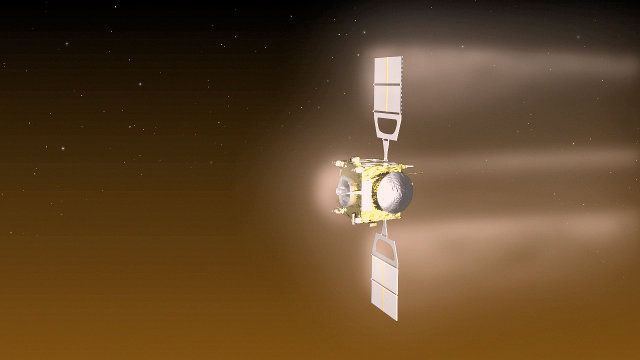
An article published in the journal “Nature Physics” describes an analysis of the data collected by ESA’s Venus Express space probe during the final phase of its mission. After about eight years orbiting the planet Venus, in 2014 it was sent down lower and lower into the atmosphere, where it collected many new data before ending up getting destroyed. This allowed for example to discover the extraordinarily low temperatures of some atmospheric waves that have an average of about -157° Celsius (about -250° Fahrenheit).
In the last months of the Venus Express mission, the remaining space probe’s fuel was used for the maneuvers that led to to perform a sort of surf on the upper limit of Venus’ atmosphere. ESA engineers exploited these maneuvers, technically called aerobraking, until the engines stopped working collecting direct information on a part of the atmosphere of the planet still not well known.
Some results were surprising, especially in the polar regions at altitudes between 130 and 140 kilometers (from 81 to 87 miles). These regions were never studied before in a direct way but only based on the detections of NASA’s Pioneer Venus space probe, which started its mission at the end of the ’70s.
The available data were collected by Pioneer Venus on other regions of the atmosphere and those about the polar regions were the result of extrapolations. The models created at the time don’t seem to be particularly accurate as to the polar regions because the study based on experiments carried out with the Venus Express probe reveals characteristics different from those calculated.
The new measurements were carried out from June 24 to July 11, 2014 as part of the Venus Express Atmospheric Drag Experiment (VExADE). The polar atmosphere temperature turned out to be much lower than expected, 70° Celsius lower. the density is also lower: from 130 and 140 kilometers it’s respectively 22% and 40% less dense than expected. At 180 kilometers (about 112 miles) altitude the density is even around half of what was expected.
Analyzing the data, the researchers found out that the polar regions are dominated by strong atmospheric waves. It’s a phenomenon that is believed to have a crucial influence in planetary atmospheres, including the Earth’s. For this reason, their study not only provides new information on Venus’ atmosphere but also improves more general models.
From a practical point of view, the aerobraking maneuvers experimented by the Venus Express space probe are similar to those carried out by other satellites and space probes in Earth and Martian atmosphere. However, it was the first time for an ESA planetary mission. The ExoMars program’s Trace Gas Orbiter recently launched will use similar maneuvers and those techniques can also be used in future missions.

